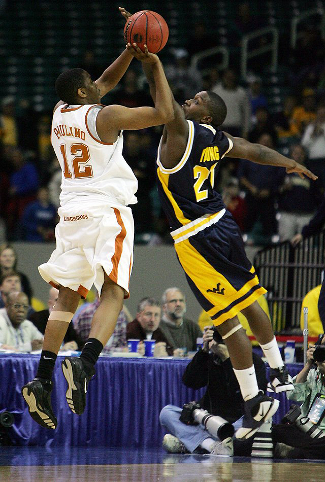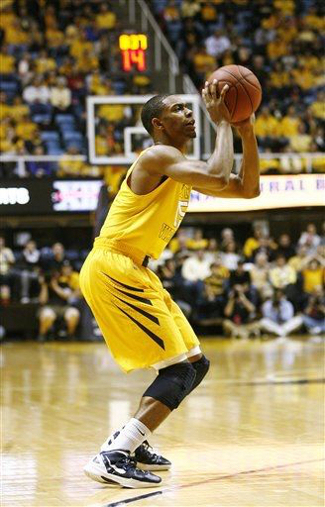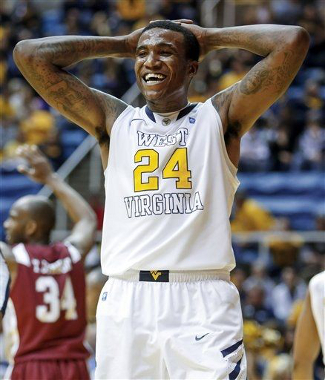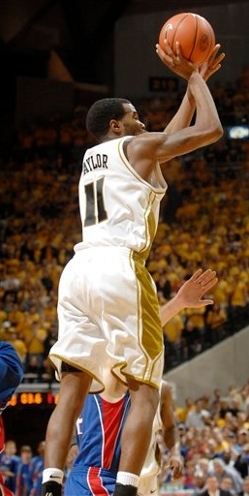Erwin Center | Austin, TX | Tip: 8 P.M. CT | TV: ESPN2 LRT Consecutive Game #235 The series between Texas and West Virginia has a short history, but it has been memorable in every way. The Longhorns hold a 2-1 edge all-time versus the Mountaineers, as WVU comes to the Erwin Center tonight for the first time as members of the Big 12.
Kenton Paulino broke the hearts of WVU fans in 2006 The teams last met in 2006, with Texas’ Kenton Paulino hitting a buzzer-beating three in the Sweet 16 just moments after Kevin Pittsnogle had tied it up on a three-pointer of his own. That was actually the second meeting of the season between the two teams, as LaMarcus Aldridge raced the length of the court to block a potential game-winning shot as time expired in a November meeting in Kansas City. While the stakes are much lower in tonight’s matchup and the squads are not quite as talented, it’s sure to be memorable, even if only for its historical importance. The Mountaineers have scuttled this season, performing well below the expectations that had them squarely in the middle of the Big 12 pack. Texas has also failed to live up to its preseason buzz, putting the Horns far outside of the bubble as league play kicks into gear. If the Longhorns have any hope to stay relevant down the stretch, they will have to take care of business at home against the teams that will finish in the bottom half of the league. Even though the Mountaineers are down, tonight’s game is still very important for Texas’ big-picture goals. By the numbers As is to be expected with any Bob Huggins team, the Mountaineers are a physical bunch that hits the glass hard and takes care of the basketball. West Virginia turns it over on less than 18% of its possessions, a mark that ranks in the Top 40 nationally. The ‘Eers also reclaim 38.6% of their missed shots, an offensive rebounding mark that is 25th-best in the country. That ability to win second chances is huge for a team that has simply struggled to put the ball in the basket all season long. West Virginia’s effective field goal percentage is an ugly 43.8%, one of the 50 worst marks out of the nation’s 347 D-I teams, and actually a few percentage points worse than Texas’ eFG%. Many of the team’s struggles come from behind the arc, where the Mountaineers have made just 28.7% of their looks. Fortunately, those extended possessions and an ability to get to the line have kept West Virginia’s offensive efficiency numbers respectable. The Mountaineers score an adjusted 1.016 points per possession according to stat guru Ken Pomeroy, with more than 24% of the team’s points coming from the charity stripe. As West Virginia moves more towards a dribble-drive offense and away from a five-man motion look, the team is only seeing that free-throw production go up. On the other side of the ball, West Virginia is statistically average. Their adjusted defensive efficiency ranks just in the top third of D-I teams, as they allow 0.958 points per possession. West Virginia’s defensive turnover percentage, defensive rebounding percentage, and defensive free-throw rate are all within a few spots of the national median. For a Texas team that is suffering from the worst offensive woes of Rick Barnes‘ tenure on the Forty Acres, that average WVU defense could make the Mountaineers very welcome visitors. Meet the Mountaineers West Virginia has a group of talented ballhandlers in the backcourt, giving Coach Huggins some lineup flexibility. It’s also allowed the Mountaineers to shift to more of a dribble-drive offense in the last few weeks, something that helps to alleviate the team’s jump shooting nightmares and leads to free points at the stripe. Sophomore guard Juwan Staten (No. 3) is the only Mountaineer averaging more than 24 minutes per game, as he clocks in for more than 32 minutes on the court every night. A transfer from Dayton, Staten can run the point, but also has incredible speed and nice driving ability to get to the rim. He has a reliable floater in his arsenal and uses good body control to get off some difficult shots against interior pressure.
Terry Henderson knocked down six triples against OU Staten’s 11 points per game and 20.4% assist rate are both tops on the team, and he also rebounds fairly well on the defensive glass. The sophomore can often be found slicing in from the weak side to snag the board and close out a good WVU stop. The 5’11” Jabarie Hinds (No. 4) is another sophomore guard with good handles, but his role is undoubtedly that of a shooter. Although he’s shown off a quick, dangerous stepback jumper at times, the young New Yorker is still battling consistency issues. Hinds’ true shooting percentage just barely cracks the 40% barrier, a major problem for a guard who doesn’t get to the rack or the line with any regularity. The third guard in the starting lineup is Terry Henderson (No. 15), an exciting freshman who played his way into the starting five after just a few games. Although he’s only made 36% of his threes on the season, Henderson is coming off a blistering 6-of-11 performance beyond the arc in Saturday’s loss to Oklahoma. The 6’3″ North Carolina product also gets out and runs the floor well in transition, and his long wingspan makes him a tough defensive presence on the perimeter. Inside, senior Deniz Kilicli (No. 13) was being counted on to help offset the losses of leaders Kevin Jones and Truck Bryant from last year’s team. Unfortunately, his consistent foul trouble has limited his time on the court and made it tough for him to be the veteran leader this young team needs. When he’s on the court, Kilicli is one of the nation’s best offensive rebounders and uses brute strength to get to the rim. He also loves the hook and baby hook, but will take both almost exclusively with his left hand. Opponents who take away his preferred hand can easily turn him into nothing more than a passing big man who has to score on putbacks. The other thing that West Virginia is missing with the departure of Jones and Bryant is scoring. That pair accounted for 52% of the team’s points last season, and La Salle transfer Aaric Murray is helping to pick up some of the slack inside. Like Kilicli, Murray has battled foul trouble this season, and is often visibly frustrated when relegated to the bench. Early whistles can get in the big man’s head and quickly throw him off his game.
Aaric Murray is easily frustrated by foul calls When Murray is clicking, though, he has a very nice offensive package. His soft touch and smooth spin moves make it easy for him to score in the post, and the recent development of his outside game just makes him a tougher matchup. Murray still needs to work on his interior passing, but he is still a reliable scorer and rebounder who averages 10.5 points and 7.5 boards per game. When Kilicli and Murray find themselves in foul trouble, senior Dominique Rutledge (No. 1) sees a spike in minutes. He has a nice wingspan, does an excellent job on the defensive glass in his limited minutes, and is crafty with the ball when they feed him in the paint. While he’s averaging only about 13 minutes per game, Rutledge has been called upon for some 20-plus minute performances on nights where Kilicli and Murray can’t manage to stay on the court. The other big man on the bench is 6’10” sophomore Kevin Noreen (No. 34), who has yet to make much of an impact in his year and a half. He’s averaging almost 15 minutes per game, up a bit from his 12 minute average of last year, but he usually contributes just a few boards during his short stints on the court. Off the bench, sophomore Gary Browne (No. 14) is the third ball-handling guard for Coach Huggins, and his extensive experience as a freshman makes him a dangerous sixth man. Although he’s another option to run the point, Browne definitely has a scorer’s mentality and an ability to get himself open looks. Like most of the team, however, the sophomore isn’t consistently making those open looks, shooting just 31.1% from the floor and 18.2% behind the arc. Fellow sophomore Keaton Miles (No. 55) also brings a lot of experience from his freshman year, when he started numerous games at the three. He’s a strong, broad-shouldered 6’7″ forward from Dallas who isn’t much of an offensive threat, but can be downright annoying on the defensive end. His block percentage and steal percentage both rank in the Top 200 nationally, as he has posted 5.7% and 3.5% so far, respectively. Freshman guard Eron Harris (No. 10) rounds out the core rotation, chipping in about 12 minutes per game. Although he’s made an impression on the defensive end when the Mountaineers turn up their pressure, he has also proven that he can pile up some points in a hurry. In just his second collegiate game, Harris put up 15 points in a blowout of Marist at the Old Spice Classic, one of four times he’s cracked double-digits in scoring this season. Keys to the game 1) Limit West Virginia’s second chances – The Longhorns did a fantastic job on the defensive glass against Baylor for the first 20 minutes of Saturday’s game. It was their inability to close out possessions down the stretch that proved deadly, however, as the Bears reclaimed more than 54% of their misses in the second half. West Virginia is a great offensive rebounding team, and it’s one of the few things they do well on that half of the court. The Longhorns have showcased one of the nation’s best defenses so far this season, but that won’t mean much if they allow the Mountaineers second and third chances. If Texas can lock down the glass, their solid defense and the struggling West Virginia offense should combine to keep the ‘Eers from lighting up the scoreboard. 2) Keep West Virginia off the charity stripe – Another crippling blow to Texas’ upset chances on Saturday was a defensive free throw rate of 70.3%. In simpler terms, that means that the Longhorns sent the Bears to the line seven times for every ten field goals that Baylor took. While the Bears managed to do this by attacking the paint with a dominant front line, West Virginia gets to the line thanks to some quick, shifty guards. The method may be different, but the concern is the same for Texas. The Mountaineers score nearly a quarter of their points from the stripe and shoot roughly two free throws for every five field goals. The Longhorns need to turn back West Virginia’s dribble penetration and avoid giving up free throws when the primary defenders can’t hold the guards. 3) Handle West Virginia’s pressure on the perimeter – The Mountaineers aren’t a bunch that will turn opponents over with much frequency, but they do love to frustrate opponents with pesky pressure on the perimeter. West Virginia makes it difficult for other teams to get their half-court sets going, challenging opposing guards well beyond the arc and forcing plays to start 20-plus feet from the hoop. Texas has struggled with turnovers all season long, even against teams that don’t traditionally force miscues. One place where the Longhorns have been particularly bad at ball control is on the perimeter, where lazy feeds and telegraphed swing passes are picked off and turned into fast break points. The Longhorn guards have to be aware of this potential for disaster and make passes with purpose, especially when working the ball around the arc. |












 1
1  2
2 
